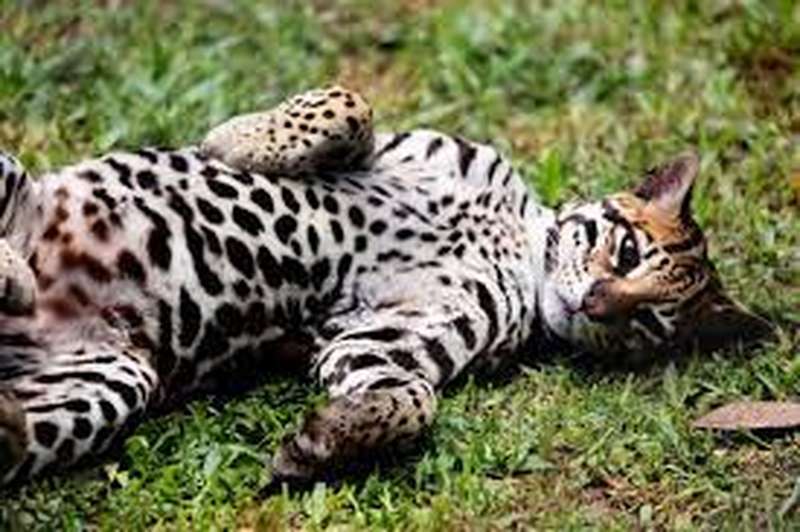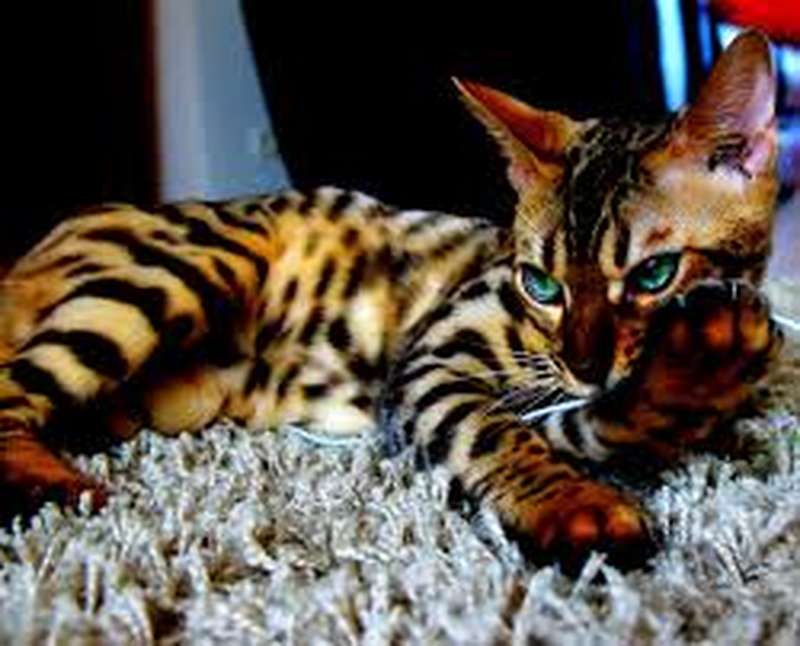Bengal cats are smart and active, and their stunning coats make them popular. These loving kitties are a mix of domestic cats and wild Asian leopard cats.
Bengal Cat Overview
| OFFICIAL NAME | Bengal |
| COMMON NAME | Bengal |
| PET HEIGHT | 8 to 10 inches |
| PET WEIGHT | 8 to 15 pounds |
| LIFESPAN | 9 to 15 years |
| GOOD WITH | cats, children, dogs, families, seniors |
| TEMPERAMENT | affectionate, bold, sociable |
| INTELLIGENCE | high |
| SHEDDING AMOUNT | normal |
| PLAYFULNESS | high |
| ENERGY LEVEL | active |
| VOCAL LEVEL | frequent |
| COAT LENGTH | short |
| COLORS | chocolate / brown/sable, lavender/silver |
| OTHER FEATURES | amiable to humans, other animals, and strangers; easy to educate; easy to groom; high prey drive; strong loyalty inclinations. |
Bengal Cat History
The credit for the first documented Bengal cat goes to Jean Mill, a breeder based in California. In 1963, she created this breed by crossing a Domestic Shorthair with an Asian Leopard cat. These cats are considered a relatively new breed, especially when compared to Persian cats, which can trace their origins back to the 1600s.
Asian Leopard cats are a species of wild felines that inhabit various regions in Asia. They are comparable to domestic cats in size. These cats have inherited several characteristics from the Asian Leopard, including their distinctive spots, energetic nature, and affinity for playing in water.

Bengal Cat Dimensions
Bengal cats typically have a medium to large size. The weight of these animals can vary between 8 and 15 pounds or even more. Additionally, their height can range from approximately 13 to 16 inches. Certainly, it is important to note that these statements are generalizations and individual Bengal cats may exhibit varying characteristics.
A Leopard-Like Appearance
One of the most noticeable physical traits of Bengal cats is their leopard-like spots or rosettes. The spots of this animal can appear in various colors, including rust, chocolate brown, or black.
The coats of these animals can come in a range of colors, such as golden, rust, brown, orange, sand, and ivory. Certain Bengal cats possess fur that glistens in the light, resembling a delicate dusting of glitter. Bengal cats are characterized by their small, round heads, large eyes, and distinctive facial markings.
These animals possess robust muscular bodies and exhibit a sleek appearance reminiscent of their Asian Leopard ancestors. The hind legs of these animals are longer than their front legs, which contributes to their ability to move with both power and grace.
The Temperament of a Bengal Cat
A cat’s personality is greatly influenced by its environment and experiences. However, Bengal cats do possess certain characteristics that can be traced back to their wildcat ancestry. For example, these animals are known for their high intelligence, boundless energy, unwavering confidence, and constant vigilance. These traits are essential for their survival in the jungle.
Interesting Data About Bengal Cats
Apart from their affinity for water, Bengal cats have numerous other fascinating characteristics worth mentioning. Here are some of the most intriguing ones are listed below:
- In the 1970s, the name of Bengal cats was changed from Safari Cats to Prionailurus bengalensis, which is the scientific name of the Asian Leopard cat they are descended from.
- They have been desired as pets over the years due to their resemblance to wildcats. It has been reported that a woman in London spent $50,000 on her Bengal cat. They were given the nickname “Rolls Royce of Cats” due to their exceptional qualities.
- Bengal cats have a unique meow that differs from the typical meow. They produce a raspy noise that can resemble a bark.
- These cats possess highly agile paws and are capable of flipping light switches on and off.
Names of Bengal Cats
Coming up with a name for a new kitty can often be a challenging task, particularly when it comes to finding a name that satisfies everyone in the family. When choosing a name for your Bengal cat, consider selecting one that pays homage to their wildcat heritage.
Some examples of suitable names could be Leo, Simba, Hunter, or Tigey. Another option is to give them names based on their coat patterns, like Spots, Patches, Speckles, or Copper.
Top Claims About Bengal Cats
Bengal cats are generally in good health and can live an average of 12 to 16 years or even longer if they receive proper care.
However, it is important to note that they can still experience injuries or illnesses. The most frequently reported illnesses among ASPCA Pet Health Insurance customers who own Bengal cats are:
Lymphoma – Lymphoma is a form of cancer that affects lymphocytes, which are a specific type of white blood cell associated with the immune system.
An Ear Infection – This is a common ailment among cats, which can typically be easily treated with drops, especially when detected early.
Eye disorders – One of the most frequently occurring eye disorders in cats is conjunctivitis, which is also referred to as pink eye.
Weight loss – A decrease in weight can be a sign of various diseases or issues, such as anxiety resulting from a change in routine.
Urinary Conditions – There are various issues that can cause urinary problems for your cat, ranging from urinary stones to Feline Interstitial Cystitis (FIC).
Stomach Problems – Tummy trouble, similar to weight loss, can be attributed to various factors, ranging from ingesting toxic plants for cats to experiencing illnesses such as pancreatitis.
Claims related to behavioral conditions are also commonly submitted. Behavioral issues can occur when Bengal cats do not receive the necessary level of engagement they typically require.
ASPCA Pet Health Insurance provides coverage for these conditions because they can cause stress for the cat, disrupt the household, and potentially lead to the cat being surrendered to a shelter.
It is preferable for the well-being of everyone involved if the cat can be kept contentedly within the home and provided with assistance through behavioral modification, medication, or other appropriate treatments.

Proper Care for Your Bengal Cat
- Bengal cats have the same basic care needs as any other cat. For example, it is important to provide them with a nutritious diet, trim their nails as necessary, and maintain regular teeth brushing. However, it is important to consider a few key points when taking care of your Bengal cat:
- Bengal cats are not heavy shedders and generally groom themselves sufficiently. However, it is still important to regularly brush them to maintain the health of their coat and skin. Occasionally, they may require a bath, particularly if they come into contact with something particularly messy.
- To keep your Bengal cat engaged, consider providing them with cat-safe puzzle toys or interactive toys that they can activate independently.
- One great and inexpensive way to entertain your Bengal cat is by setting up a few paper bags or boxes for them to dart in and out of. Another option is leaving ping pong balls around the house. You can also consider making homemade cat toys.
- Bengal cats have a natural inclination for climbing and greatly appreciate having ample vertical space. To satisfy their natural inclination for height, you can provide your cats with sturdy climbing trees, tall scratching posts, and window perches.
- The ASPCA recommends that cats be kept indoors to ensure their safety by minimizing the risk of injury, as well as reducing the chances of contracting diseases or parasites. It is particularly crucial to be cautious with Bengal cats because they are highly sought after for their distinctive appearance and may be at risk of theft. Additionally, by owning a Bengal cat, you will also be safeguarding small wildlife such as birds and squirrels due to their natural instinct to hunt.
- It is important to schedule regular check-ups and professional teeth cleanings for your Bengal cat at the veterinarian’s office. An ASPCA Pet Health Insurance plan can cover the cost of an annual exam and dental cleaning. Additionally, there is an optional preventive care package available.
And, of course, the most important aspect is to shower your cat with the love and attention they crave and deserve!
Adopt Bengal Cat
These cats are renowned for their remarkably beautiful coat patterns, which closely resemble those of their wild ancestors. However, unlike their ancestors, Bengals are known for being incredibly friendly and affectionate companions.
With their high energy levels and love for playtime, they are the ideal companions for active families or individuals seeking a furry friend to keep them engaged. With an average weight ranging from 10 to 15 pounds, these animals are the ideal size for cuddling on the couch after a day filled with exciting adventures.
If you are seeking a cat to adopt that embodies both a wild and wonderful nature, the Bengal breed may be an ideal choice for you.
What is the price of a Bengal cat?
The cost of a Bengal kitten can vary based on factors such as the breeder, the age of the cat, and the lineage of the kitten. The average cost of a Bengal kitten ranges from $1,500 to $2,500. The average amount is typically around $2,000. Prices can vary significantly, ranging from as low as $800 to upwards of $10,000 or even more.
Which color of Bengal cat is the most expensive?
The Silver Pixie is considered the most expensive color variant among Bengal cats. The Silver Pixie Bengal is a highly sought-after breed known for its unique coat pattern, which closely resembles that of a snow leopard.
The cost of a Silver Pixie kitten can range from $8000 or higher, depending on factors such as its bloodline and lineage. Bengal Cats in this color are also considered to be quite rare, as they are not as commonly seen as other color variations.

The price of vaccinations and other healthcare costs for this cat.
It is essential to keep your Bengal cat healthy by providing regular check-ups and vaccinations. The cost of vaccination and other medical expenses for Bengal cats can vary based on your location and the level of care you choose to provide.
Here is a breakdown of the average costs associated with the medical expenses of a Bengal cat:
| Medical Expense | Cost |
| Basic Check-Up | $50-$100 |
| Vaccinations | $50-$100 |
| Spaying/Neutering | $200-$500 |
| Emergency Visits | $500-$5,000 |
In addition to the aforementioned costs, it is important to consider budgeting for flea and tick prevention, dental cleanings, and unforeseen medical expenses.